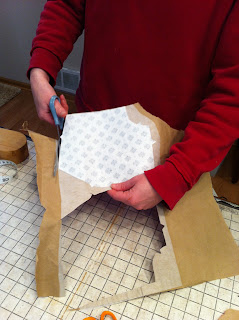My gripe isn't with the sales person (who likely doesn't sew) and is simply following the bosses instruction. I would like to see that any and all stores that sell fabric, and are pinching the fabric pennies, permanently change their procedure to include either tearing the fabric at both ends (where possible) or by taking the time to pulling a cross thread. This would also save me a step in the preparation process.
Once a (washable) piece of fabric gets home, it goes straight into the wash. I could minimize some fraying if I serged the cut ends, but I don't see the point to it because I have to cut the ends off anyway.
My fancy diagram is meant to show that whether measured from the selvage or the fold, it cannot come out quite right. When a fabric isn't cut on grain, the waste is also significant. Why straighten the grain? Because the fabric can't be folded together properly, and the paper pattern won't be laid perfectly on grain if I don't have a straight edge to start with, both length and width. To do this, I align the selvage and cross grain perpendicular to each other along a gridded cutting board before layout. This step is especially critical with slinky or silky slippery fabrics.
To find the cross grain, cut into the selvage about 1/2". If the fabric is a natural fiber (and sometimes a weak polyester can be torn), the yardage can be torn at this point. If not, find a thread to pull. Pull that thread all the way across, carefully cutting with scissors along line left behind.Yes, the thread will likely break, but grab another next to it and keep going.
As I follow the actual thread, you can see how it's getting much wider. How much fabric do you think I will lose once I get to the other side?
What started out to be a 1" trim turned into 4". That's nearly an 1/8th of a yard!
So what can we do about this?
- Right away, ask the attendant to cut or tear your yardage before and after with the cross grain. (I've noticed that my JoAnn store has begun to ask if you'd like your fabric torn, but only after they've measured it).
- Don't chat with your cutter, and do count with them. I have never come up with too much over, but have been shorted many times, even up to a yard of fabric.
- If you end up short, even after washing, call the store. As long as you don't cut into your fabric, JoAnn will exchange or accept returns for yardage with a receipt.
- If your store cuts fabric with the grain already, PLEASE thank them for their care and concern, not just because it's good for their bottom line, but because you also get full use of the fabric you've paid for.




















